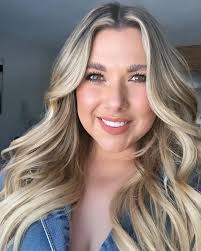Extensions for Thick and Coarse Hair: What Actually Works
I'll never forget this client, Monica, who came in about three years ago. She had this incredibly thick, beautiful hair. The kind of hair that looks amazing but takes an hour to blow dry. She wanted length, but she was worried. She said, "I already feel like my hair is so heavy. Won't extensions make it worse?"
It's something I hear all the time from clients with thick hair. They don't need volume. They have plenty of that. They want length, maybe some dimension with color, but they're scared extensions are going to make their head feel even heavier or look bulky and obvious.
Here's what I've learned: thick hair is actually ideal for extensions in a lot of ways. You just have to approach it differently. It's not about adding volume. It's about creating length and shape without adding unnecessary bulk.
Let me walk you through what actually works.
What Clients with Thick Hair Really Want
Most of my thick-haired clients aren't asking for more fullness. They're asking for one of two things: significant length or color without bleaching their natural hair.
That changes everything about how you approach the extensions. You're not filling in gaps or adding volume. You're building length and dimension. That requires real skill in blending, weight distribution, and picking the right method to create a seamless flow from their natural hair into the extensions.
The biggest fear thick-haired clients have is that extensions will make their hair feel bigger and more unmanageable. Your job is to show them that won't happen.
Figuring Out What You're Working With
Before you do anything, you need to really understand the client's hair. Thick hair isn't all the same.
Is it dense or coarse? Or both? Dense means lots of individual strands. Coarse means each strand is thick. Some people have both. Understanding which you're dealing with changes what method you use and how you apply it.
How heavy is their natural hair? This tells you how much extension hair you can add without making them uncomfortable or putting too much strain on their scalp.
Where does their natural hair end? The thicker the ends, the more careful you have to be about blending so you don't create a harsh line where the extensions start.
I had a client last year, Denise, who had dense hair but each strand was actually pretty fine. Someone else might have looked at her and assumed she needed the same approach as someone with coarse hair. But she didn't. Getting that assessment right made all the difference.
The Best Methods for Thick Hair
Not every extension method works well with thick hair. You need security, durability, and methods that can be customized to blend into all that density.
K-Tips (Keratin Bonds)
These are fantastic for thick hair because they're so secure and customizable. The bonds move in every direction naturally, so they don't get tangled or matted at the root.
Why they work: The keratin bond creates a really solid attachment that can handle the texture and weight of coarse hair. You can place them strategically to break up bulk instead of adding to it. They integrate seamlessly instead of sitting on top.
Machine Wefts
While hand-tied wefts are great for fine hair, machine wefts are better for thick hair. They're more durable and substantial, so they don't get lost in all that natural hair. They provide a dense curtain of length that matches the client's own density perfectly.
Why they work: You can get significant length and coverage with fewer rows. That minimizes weight on the scalp while still giving you a dramatic result. Plus, they're built to last. They hold up between move-up appointments even for clients who are hard on their hair.
Tape-Ins
Tape-ins can absolutely work for thick hair, but you have to be careful with the application. If you sandwich too much natural hair between the wefts, the bond won't seal right and they'll slip.
Why they work (when done right): Success comes down to taking clean, precise sections that aren't too thick. They're excellent for adding color without chemicals or filling in areas around the face where you need a flat, seamless look.
Application Is Everything
Picking the right method is only half of it. How you apply them is what creates a comfortable, invisible, long-lasting result.
Sectioning Strategies
With thick hair, a standard horizontal pattern can create too much bulk. Sometimes I use angled sections instead. It helps the hair lay flatter and blend more naturally.
I also leave a bit more space between rows. The client's natural density fills in the gaps, and it prevents that heavy, helmet-head feeling.
Strategic Thinning (Done Carefully)
This is advanced and you have to be really careful with it. Sometimes I'll very subtly texturize or slide-cut a small amount of the client's natural hair only in the spots where the extensions will attach. This isn't about thinning their overall hair. It's about creating a small pocket for the bond or weft to sit in so it lays flat and blends perfectly.
Monica, the client I mentioned at the beginning? This technique made all the difference with her hair. Without it, the extensions would have sat on top of her hair and looked obvious. With it, they blended seamlessly.
Weight Distribution
The goal is for clients to forget they're wearing extensions. That happens when you distribute the weight properly. Use the right amount of extension hair for their natural density and place the attachments so there's no stress on any single point of the scalp.
Taking Care of Extensions with Thick Hair
Managing extensions when you have a lot of natural hair requires a slightly different approach at home.
Dry everything completely. The base of the wefts or bonds has to be 100% dry after washing. Wet bonds or wefts can weaken and fail.
Wash and brush in sections. Trying to tackle all that hair at once leads to tangles. Work in sections and you'll have way better results.
The first few days feel different. It's normal to feel the extensions initially. That feeling goes away quickly as you get used to the slight, well-distributed weight.
My client Jessica called me two days after her appointment panicking because she could feel the extensions. I reminded her that was totally normal. A week later, she texted me saying she completely forgot they were there.
Your Questions About Thick Hair and Extensions
Will extensions make my already heavy hair feel unbearable?
Not when they're done right. The weight gets distributed so evenly that it actually feels surprisingly light and comfortable. We focus on your goals without overloading your scalp.
Can I still wear my hair up?
Absolutely. Strategic placement is key. A good stylist will place the bonds or wefts so they stay hidden even when you pull your hair up.
How do you prevent a visible line where my natural hair ends?
This is where the artistry comes in. Strategic thinning, precise color matching, and expert cutting techniques create a seamless transition. When it's done right, there's no line.
Are some methods too weak for thick hair?
Yes. Methods with delicate attachments might not provide the security you need. That's why a proper consultation matters so much. For thick, coarse hair, I usually recommend K-tips or machine wefts for the best, longest-lasting results.
Thick Hair Is a Gift for Extensions
A lot of clients with thick hair think extensions won't work for them or that they're going to feel miserable wearing them. But honestly? Thick hair is great for extensions when you approach it the right way.
You have a strong foundation. You have plenty of hair to hide the attachments. When it's done correctly with the right method and proper application, the results are stunning.
Monica ended up getting machine wefts. We added about ten inches. When she saw the final result, she couldn't believe how natural it looked and how comfortable it felt. She said, "I thought I'd hate how heavy this would be. I don't even notice it."
That's what happens when you understand thick hair and give it what it actually needs instead of treating it like every other hair type.
If you have thick hair and you've been hesitant about extensions, find a stylist who has real experience working with thick, coarse hair. Have a consultation. Ask about their approach to weight distribution and blending. Look at their work on clients with hair like yours.
The right person will understand your concerns and know exactly how to give you the length and dimension you want without any of the bulk or heaviness you're worried about.
You can absolutely have the hair you've been wanting. You just need someone who knows what they're doing.

Tiffany Loe
Owner & Master Stylist
Hair extension expert and salon owner with a passion for helping stylists succeed. Tiffany has been transforming hair and building confidence for over 15 years.




